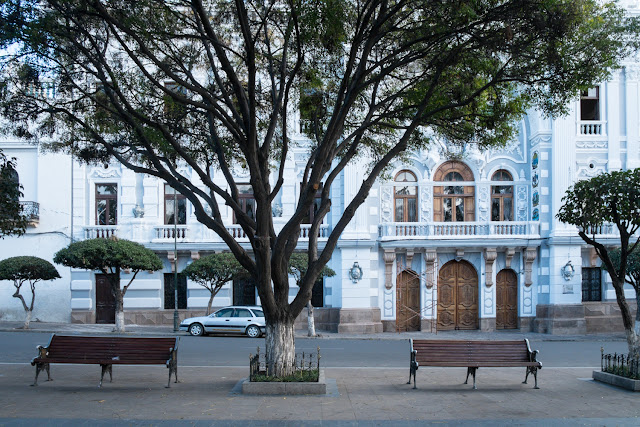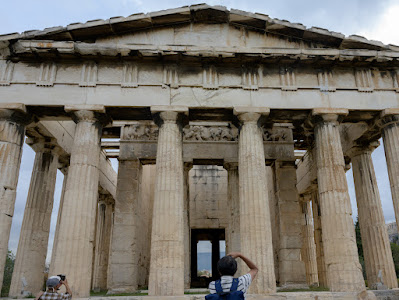5th, 6th May - Sucre, the Colonial Capital of Bolivia
We discovered that there was very little to do in Potosi on a Sunday. It is difficult to tour the churches as they are only open for services, and you cannot really walk around taking photographs during mass. Any vestige of a museum was also closed.
So we went down to the spanking new palatial bus station and caught a bus out for Sucre which lies north east of Potosi. The first taxi driver dropped us off at the wrong bus station, in spite of being told where we were going, after being surly about luggage and generally taking us anywhere at all. Perhaps he had had too much of a good time on Saturday night... or maybe not. We thought that we were going to miss the 11.00 am coach but found that it fortunately left at 11.20.
On reaching Sucre we dropped our stuff off at the hostel - the Seven Pesos, which fortunately was fairly central. We then had a walk around the city and lunched. The dish of Sucre is the saltena, which is like a Cornish pasty except spicier. It is possible to get them with different fillings and deep fried as well if you should want it. The fillings were always very runny and difficult to keep off your clothes, so they didn't make the best street food.
The next morning we walked around the central square, La Plaza 25 de Mayo, where there is a statue of Mariscal Antonio Jose de Sucre, the South American independence leader and first president of Bolivia.
Strangely enough all the zebra crossings around the square were manned by zebras stopping traffic and helping people across.
So we went down to the spanking new palatial bus station and caught a bus out for Sucre which lies north east of Potosi. The first taxi driver dropped us off at the wrong bus station, in spite of being told where we were going, after being surly about luggage and generally taking us anywhere at all. Perhaps he had had too much of a good time on Saturday night... or maybe not. We thought that we were going to miss the 11.00 am coach but found that it fortunately left at 11.20.
On reaching Sucre we dropped our stuff off at the hostel - the Seven Pesos, which fortunately was fairly central. We then had a walk around the city and lunched. The dish of Sucre is the saltena, which is like a Cornish pasty except spicier. It is possible to get them with different fillings and deep fried as well if you should want it. The fillings were always very runny and difficult to keep off your clothes, so they didn't make the best street food.
Sucre is also known as La Ciudad Blanca, the white city, as the colonial buildings are all white washed. It was pleasantly warm walking about the streets. The Spanish used the city as a refuge from the mines of Potosi and created an orderly grid layout of streets. There are a number of large schools here and at times the streets were thronged with children.
 |
| La Catedral |
 |
| La Catedral |
In 1809 the first independence uprisings started in Sucre so when Bolivia was created Sucre became its capital, and although at the end of the 19th century most of the government moved to La Paz, the legislature is still based in Sucre in a building known as La Prefectura. Now the town is more conservative and there are demonstrations against the current government of Evo Morales (the first native Bolivian president) and racist attacks on the indigenous people who voted him in to office.
 |
| La Prefectura |
The next morning we walked around the central square, La Plaza 25 de Mayo, where there is a statue of Mariscal Antonio Jose de Sucre, the South American independence leader and first president of Bolivia.
 |
| Staue of Sucre |
We visited the cathedral and the Museo Eclesiastico, which is done by guided tour. The museum contained all the normal paraphernalia, religious paintings (some by Bitti, a student of Raphael), silver plate and statues but the cathedral had a side chapel containing the Virgen de Guadaloupe, a painting of the Virgin encrusted with precious jewels given by the faithful in thanks for miracles rendered.
The guide would not let us photograph inside the cathedral but I did take some pictures of the external of the museum.
Our next stop was another museum - the Museo Universitario Charcas, which housed some modern art as well as having an archaeology and an anthropology section. It was quite an interesting place and all set around a series of colonial courtyards.
 |
| Mairi and Naomi at the museum |
Lunch was naturally a saltena each and we bought some chocolate from a lovely shop, as this is also a Sucre speciality. What more could you want!
A stroll in the park seemed fitting for an after lunch activity. The public park contains a miniature Eiffel Tower. Lots of people were either sleeping away the early afternoon or watering the grass.
 |
| The two sleepers |
There were some stalls at the side with people selling drinks and snacks.
The park was not very big so we moved on - this time to the cemetery, which we thought would be worth a visit. It was a very well kept and peaceful place with a number of city workers watering the grass and tidying up. The dead were buried in vaults stacked up like little blocks of flats. Each vault was fronted by a glass door and behind were flowers, pictures of the loved one or things they liked, for example a beer bottle or a packet of cigarettes. The children had toys and books in theirs. There were handsome family vaults belonging to the more affluent people.
I was nearly moved to tears by this poor old dog we saw outside the cemetery. He had a limp and was not in a good state. He had on a tattered dirty coat, which was more of a hindrance than anything else. Someone had loved him once to buy him that coat, but it must have been a long time ago.
As if two museums were not enough we then visited the Museo de Arte Indigena, another one set in a colonial building. This one was dedicated to the work of weavers from two Quechua speaking groups of indigenous people who live in the mountains west of Sucre. And very fine it was too, so much so that these people can now earn a good wage by producing their craft work for sale. There were also clothes you could try on and Naomi modelled a hat.
Walking back from the museum we saw this man playing an accordion.
After all this we were a little foot sore and called it a day. We bought some food and returned to the hostel to eat and sleep.























Comments
Post a Comment